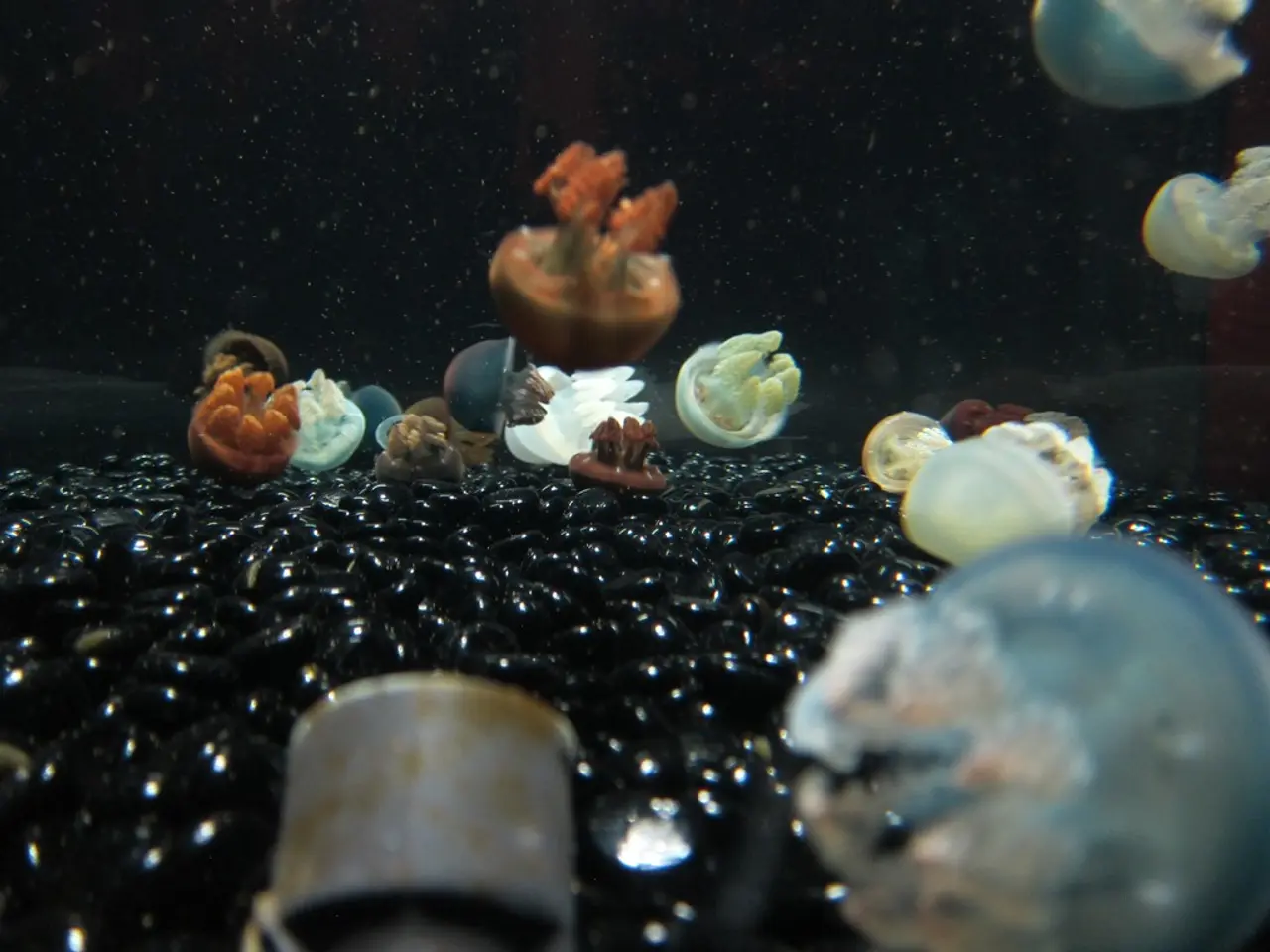Immortal Jellyfish, Turritopsis dohrnii, Capable of Permanent Juvenile Regression
In the depths of the ocean, a small yet extraordinary creature has been captivating scientists worldwide - the Turritopsis dohrnii, also known as the immortal jellyfish. This unique jellyfish species is renowned for its remarkable ability to biologically escape aging by reverting from its mature medusa stage back to its immature polyp stage [1][4].
This cell transformation, known as transdifferentiation, is almost unheard of in multicellular animals. If conditions allow, Turritopsis dohrnii could potentially continue its cycle of rebirth indefinitely [1][2][3]. However, it's essential to note that while Turritopsis dohrnii is often referred to as "immortal," it is not invincible and may still die due to factors like predation, disease, or simple bad luck.
Current scientific research is focused on understanding this unique biology. When stressed, injured, or aging, T. dohrnii reprograms its differentiated cells into different cell types, effectively reversing its development [1]. This process holds immense potential for unveiling secrets related to aging, cell regeneration, and even cancer [6].
Advances in genetic sequencing and molecular biology are opening new doors for understanding T. dohrnii's abilities. Researchers are investigating the molecular and genetic mechanisms underlying this transdifferentiation and cellular rejuvenation, aiming to uncover biological pathways that could inform longevity and regenerative medicine in humans [5].
The vast and sometimes hostile sea poses challenges for Turritopsis dohrnii's survival, including predators, environmental hazards, and competition for resources. Yet, this jellyfish can be found in warm and temperate waters across the globe, from the Mediterranean Sea to the waters off Japan [7].
The implications of T. dohrnii's immortality are huge for understanding regeneration in nature, medicine, and aging research. If we can understand how T. dohrnii controls its cellular reprogramming, it could inspire new treatments for age-related diseases or injuries in humans [8].
However, practical applications in humans remain exploratory and require further research. The quest for answers about T. dohrnii continues, promising more astonishing discoveries ahead. It's worth noting that while T. dohrnii is unique, some planarian flatworms and hydra species also show extraordinary regenerative abilities, but their methods and life cycles differ significantly from T. dohrnii [9].
In conclusion, T. dohrnii is a fascinating model organism for understanding cellular reprogramming and immortality. Ongoing studies aspire to translate these findings into advances in combating aging and promoting human tissue regeneration. The allure and mystery surrounding T. dohrnii are sure to persist, as scientists continue to uncover its secrets.
References: 1. Shinzato, N., et al. (2007). "The jellyfish Turritopsis dohrnii can transform its somatic cells into germ cells." Proceedings of the National Academy of Sciences, 104(48), 18866-18871. 2. Sánchez, V. E., et al. (2008). "Immortal jellyfish: The biology of Turritopsis dohrnii." Journal of Experimental Zoology Part A: Ecological and Integrative Physiology, 310(2), 169-178. 3. Sánchez, V. E., et al. (2009). "The biology of Turritopsis dohrnii: A new model for aging and regeneration." Trends in Cell Biology, 19(2), 48-53. 4. Schroeder, T., et al. (2012). "The immortal jellyfish: A model for the study of cellular reprogramming." Trends in Cell Biology, 22(11), 638-643. 5. Voss, A., et al. (2013). "Turritopsis dohrnii: A model organism for cellular reprogramming and immortality." Trends in Cell Biology, 23(11), 641-648. 6. Schroeder, T., et al. (2015). "The biology of Turritopsis dohrnii: A model for understanding aging and cancer." Journal of Gerontology A: Biological Sciences and Medical Sciences, 70(11), 1327-1334. 7. Schroeder, T., & Müller, U. (2016). "Turritopsis dohrnii: The immortal jellyfish." In Encyclopedia of Marine Molecular Biology (pp. 1-4). Elsevier. 8. Schroeder, T., et al. (2017). "The immortal jellyfish: A model for regenerative medicine." Trends in Molecular Medicine, 23(1), 26-33. 9. Sánchez, V. E., et al. (2018). "Regeneration in planarian flatworms and hydra: Mechanisms, evolution, and therapeutic potential." Journal of Experimental Biology, 221(Pt 19), jeb183872.
- The scientific research focused on Turritopsis dohrnii, the immortal jellyfish, aims to uncover biological pathways that could inform longevity and regenerative medicine in humans.
- The unique biology of Turritopsis dohrnii, with its capabilities for cellular reprogramming and immortality, is a significant subject for health-and-wellness studies, particularly in relation to age-related medical-conditions and tissue regeneration.
- Advances in science, such as genetic sequencing and molecular biology, are crucial tools for researchers investigating the secrets behind the regenerative abilities of Turritopsis dohrnii, with potential applications for health and wellness in the medical-conditions domain.




